Russian Sage
Russian sage is a low-water shrub grown for its blue-purple flower spikes that appear in late July. The flowers appear on branched stems at the tips of each branch. Its branches grow in an upright manner, forming a rounded, open shrub.
The highly aromatic leaves are gray-green and covered by a soft, downy fuzz. Russian sage is a very resilient, easy to grow plant. It also attracts honey bees.
Russian sage spreads vigorously through underground runners and seed. It can be challenging to remove once it is established.
.jpg)
.jpg)
.jpg)
.jpg)
.jpg)
.jpg)
.jpg)
Russian Sage
Russian sage is a low-water shrub grown for its blue-purple flower spikes that appear in late July. The flowers appear on branched stems at the tips of each branch. Its branches grow in an upright manner, forming a rounded, open shrub.
The highly aromatic leaves are gray-green and covered by a soft, downy fuzz. Russian sage is a very resilient, easy to grow plant. It also attracts honey bees.
Russian sage spreads vigorously through underground runners and seed. It can be challenging to remove once it is established.
Plant details
Botanic Name
Perovskia atriplicifolia
Pronunciation
per-OFF-skee-uh at-ry-pliss-ih-FOH-lee-uh
Mature Height
3 to 5 ft.
Mature Spread
3 to 5 ft.
Water usage
One Droplet: Water twice per month or less, once established.
Two Droplets: Water about once per week, once established.
Three Droplets: Water about twice per week, once established.
Flower Color
purple, lavender
Bloom time
late July through August
Colorado Native
No
Natural Habitat
Afghanistan
Light Requirements
sun
Cold Hardiness
USDA zones 5-9
Elevation Limit
hardy to 8,000 ft.
Performance
This was one of the first plants placed in the Water Wise Demonstration Garden. The flowers are very attractive and add late summer color to the landscape. It combines with ornamental grasses and flowers very well.
Although it grows from a central crown for the first few years, Russian sage will form a large colony over time through underground stems. If this is not desired, it can be root pruned with a shovel. It is not impacted by over-the-counter herbicides and can be challenging to remove.
Russian sage is not that attractive in the winter, so put it next to other plants that have more winter interest.
Maintenance
Prune out any winter-killed branches as needed. Depending on the severity of the winter, the branches may die back over halfway, even to ground level. Russian sage will spread by seed and underground stems, forming a large colony over time. Remove spent flowers stalks to prevent spreading by seed.
See in a landscape
It may surprise you, but this entire yard is xeriscape! The plants in this landscape are all well adapted to Colorado and grouped according to water need which makes the best use of water in the landscape. The turfgrass is a dwarf tall fescue and looks great with 2/3rds the water of traditional grass. A tip for large yards like this one is to plant in groups to create unity and interest and to choose larger xeric shrubs where possible to help reduce maintenance.
This front yard is a nice balance between contemporary and native using buffalograss as a natural looking grass area with shrubs and perennials that add color and texture to the landscape. These plants are low to very low water use and require maintenance only one or two times of year, making this yard low water and low maintenance. Since buffalograss grows less than 6 inches tall, this front yard could even go without mowing.
This large backyard backs up to a golf course and was previously over 3000sqft of Kentucky bluegrass. Since the backyard received little use, the high water-using bluegrass was converted to Colorado's state grass, Blue grama, and saves about 60% of the water. Many of the plants in this landscape are xeric plants that compliment this native turf well and fit right into the surrounding Colorado backdrop.
With higher water using plants like Kentucky bluegrass, it's important to make sure that the ground is level where it's planted to prevent the water from running right off when watered. The stone walls in this yard help make a flat place to plant and add interest and texture to the front yard. Because this yard is so big, much of the grass was removed from where it was not useable, and shrubs and low maintenance perennials were planted instead. Wood chip mulch helps the soil from drying out in the heat of the summer and also helps to prevent weeds from growing around the plants.
This front yard gets creative with landscaping without bluegrass. The dry streambed and various mulch areas help break up large spaces and create areas to leave unplanted and other areas to plant. The plants in this landscape are trees, shrubs and ornamental grasses that need very little maintenance and only a few flowering perennials that need a little more maintenance. This yard creates a unified look by repeating mulch and plants on both sides of the driveway and the parkway, giving this mountain xeriscape a complete look.
This renovation eliminated all bluegrass from the plan, and instead took advantage of plants that offered a variety of color and texture. This yard had a few different challenges when considering a new landscape: slope, deer, western exposure and low water and maintenance needs. The rock chosen for this yard is slightly angular so it doesn't roll downhill easily, the plants are selected for deer resistance and heat loving which is necessary for a west facing yard that has a heat-holding rock mulch. In fact, many of these plants actually prefer rock mulch rather than wood mulch that may hold too much water too near the plant. And finally, the landscape is watered with drip irrigation to make best use of water. With drip irrigation, water is applied only where the plants need it, and not in unnecessary areas where only weeds might grow, saving time with maintenance.

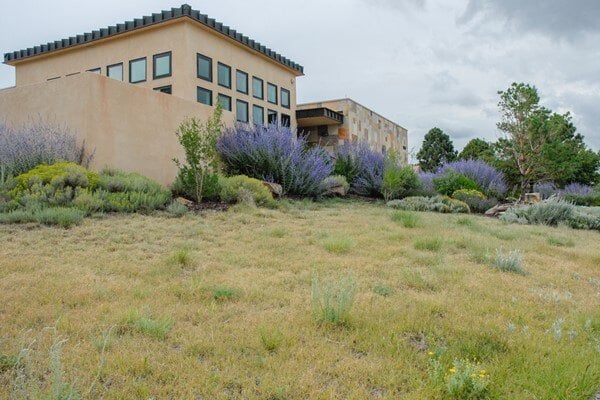
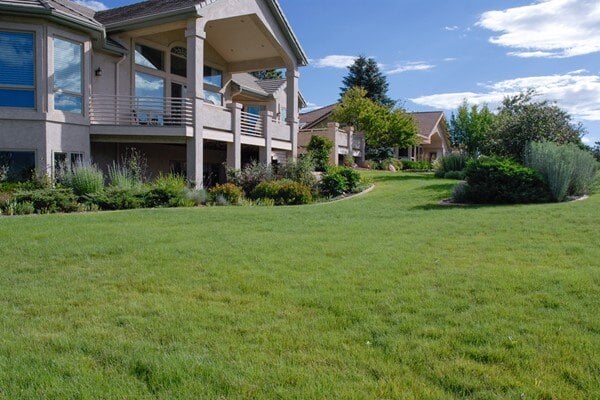
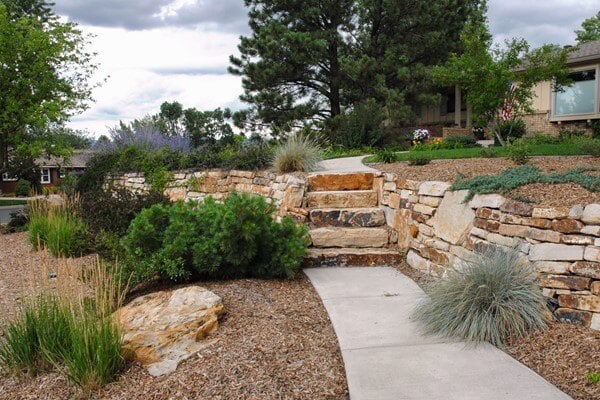
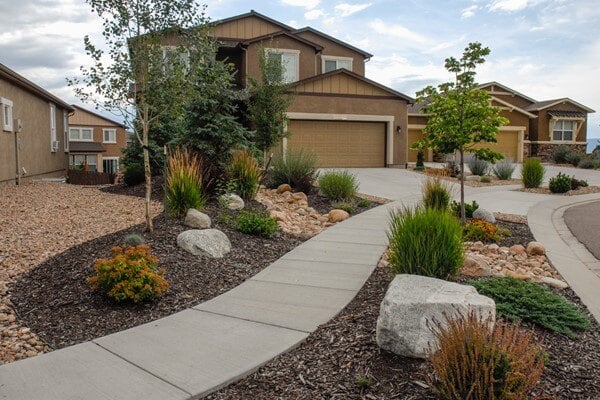
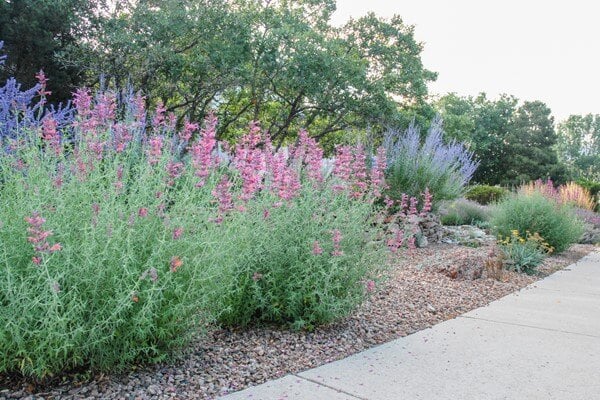
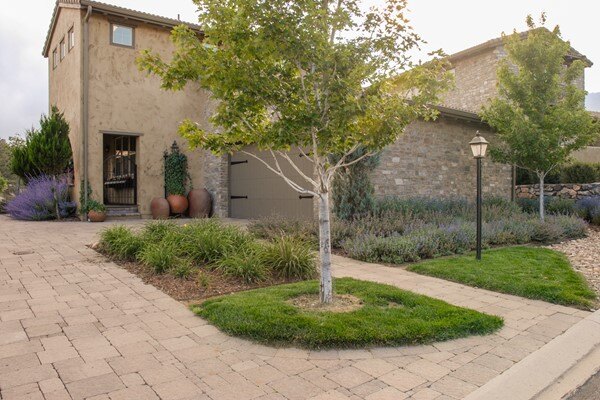
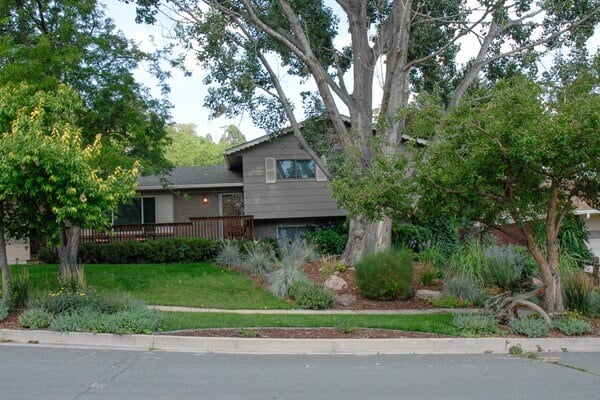
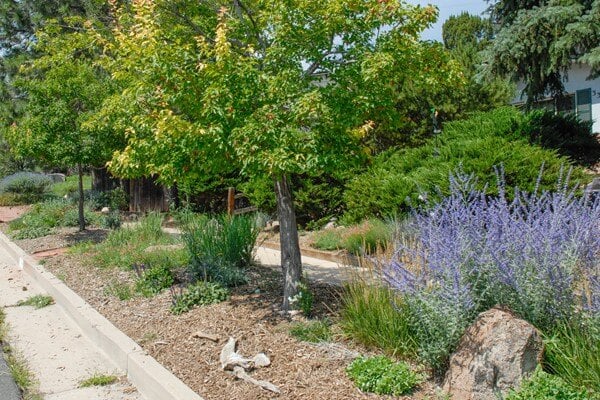
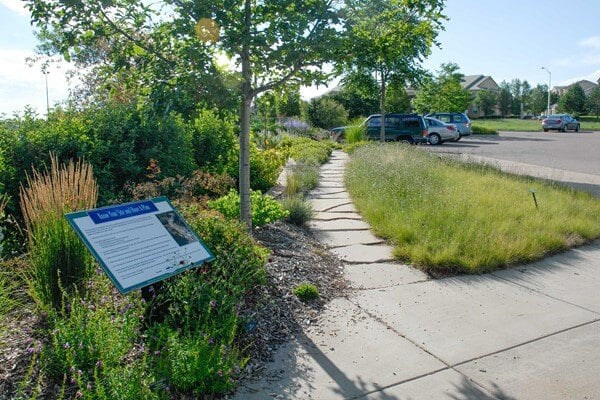
.jpeg)
.jpeg)
.jpeg)
.jpeg)
.jpeg)
.jpeg)
.jpeg)
.jpeg)
.jpeg)
.jpeg)